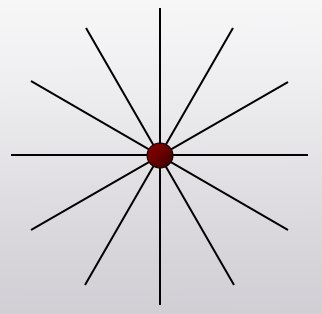Greetings from chilly Toronto, where I’m briefly in town to participate in a public event about the Higgs boson tonight. Should be a good time, especially because it’s not just me giving a talk; I will spend 20 minutes explaining the theoretical motivation behind the Higgs, after which experimentalists Pierre Savard and William Trischuk will talk about the actual experiments.
Which raises the question: how does one explain the theoretical motivation behind the Higgs, given a small number of minutes and a motivated-but-nonexpert audience? It’s something I should have figured out by now, having written a book and all. But I’ve been fishing around, and I think I’ve finally settled on a favorite approach to doing it.
A couple of preliminary notes. I don’t think there is a good explanation of the Higgs boson at the sound bite level, say 15 seconds or less. That’s because you need to explain two distinct things: first, that there is a Higgs field filling space that interacts with the particles moving through it and giving some of them mass; and second, that the Higgs boson is the particle we observe when we interact with a vibration in that field. Both of these ideas are part of quantum field theory, which we generally don’t try to explain in physics popularizations, so it’s more than a few seconds of work to get them across. But I don’t think there is a shortcut: if you want to explain the Higgs at all, you have to explain the Higgs field.
With that in mind, the biggest stumbling block to providing a convincing popular-level motivation for the Higgs field is that we immediately leap to the idea that the role of the Higgs is to “give particles mass,” where by “particles” we really mean “quarks, charged leptons, and the W & Z bosons.” This raises a couple of problems. First, why do we need some mechanism to give particles mass? Why can’t they just have mass? Of course some particles can just have mass — like the Higgs itself. So you’re starting off by moving backwards, bringing up the need to explain why different symmetries apparently prevent particles from having mass, which is actually harder to explain than the Higgs mechanism. And second, most of the mass in real objects comes from QCD, not from the Higgs mechanism at all, so you are almost inevitably giving people the wrong idea. You see why it’s a tricky situation.
Fortunately, we have an alternative: the actual historical development of the subject. Back in the early 1960’s when the Higgs mechanism was being proposed (by Anderson, Englert, Brout, Higgs, Hagen, Guralnik, and Kibble), they weren’t trying to give mass to fermions. They were trying to explain how nuclear forces, which manifestly only stretch over a very short distance, could possibly be described in a way similar to gravity and electromagnetism (i.e. by Yang-Mills theories), which manifestly stretch over long distances. Sure, both gravity and E&M fade away as you move farther from a source, but they do so slowly (the inverse square law, in particular), which is why they are relatively easy to observe in the everyday world. If the nuclear forces are simply generalizations of E&M, as Yang and Mills suggested, why don’t they stretch over large distances?
 Here is the analogy I’d like to suggest. Think of someone holding a lantern on a dark night. As that person moves farther away from you, the light you receive from the lantern grows dimmer; indeed, it follows exactly an inverse-square law. That makes sense, when you simply think of the rays of light emerging from the lantern in three dimensions. Long-range forces are like that, with “rays of light” replaced by “lines of force.”
Here is the analogy I’d like to suggest. Think of someone holding a lantern on a dark night. As that person moves farther away from you, the light you receive from the lantern grows dimmer; indeed, it follows exactly an inverse-square law. That makes sense, when you simply think of the rays of light emerging from the lantern in three dimensions. Long-range forces are like that, with “rays of light” replaced by “lines of force.”

So what you want to account for is how a lantern could seem quite bright when it was nearby, but quickly fade to almost nothing as it moves just a short distance away. That is, how a force could be noticeable at short range, but cut off dramatically at longer distances.
Well, there are a couple of ways to do it, and nature takes advantage of both of them. One way is to simply put some kind of shield or shutter around the lantern, keeping the light trapped inside. If you were inside the shutter, the lantern would look quite bright; but as soon as you step outside, you can barely see it if at all.
We call that phenomenon confinement. It’s what the strong nuclear force does. The force-carrying bosons (gluons) are still massless, but they interact with each other so strongly that they can’t leak outside. If you were inside a nucleus, the strong force would seem quite strong; outside, it’s barely noticeable. (To make the analogy exact you would have to make the shutter itself out of light, but analogies are rarely exact.)

The other possibility is that the lantern is unshuttered, but that the air is full of fog. (Something truly absorbing rather than scattering would make for a more exact analogy, so maybe smog would be better than fog.) Then the light from the lantern can’t propagate very far because it is absorbed by the medium filling the space between it and you.
That’s the Higgs mechanism, and it’s what makes the weak nuclear force short-range. There is a field filling space, which absorbs the lines of weak force. It’s a pretty good analogy to the fog; in both cases, the absorbing material creates an effectively short-range phenomenon. If you were closer to the lantern than the attenuation length in the fog, you would be able to see it with no problem; likewise, if you are closer to a source of the weak force than the mass of the W/Z bosons, it would be very noticeable. This analogy, one hopes, helps get across the need for a field filling space, which is what the Higgs field is all about.
Now of course you should probably try to explain why fog would give mass to something. That’s left as an exercise for the reader.
Sean has done an outstanding job explaining how the Higgs field and Higgs particle works. His book is well worth reading! Good work Sean.
My favorite anaology explaining the Higgs field is a dolphin swimming through water is faster than a whale. Because of the Higgs particle, the dolphin has less mass compared to the whale.
I am having difficulty subscribing to this feed in Google reader and the “subscribe to” option under book marks (in Firefox) is greyed out.
Is something wrong with the feed setup (google reader says url is not valid)?
Scott
Should have no trouble subscribing directly from here:
http://preposterousuniverse.com/blog/feed/
Sean , you explain the Higgs as good as you always have . I am still reading your new book, ch 4, and will be spending lots of time reading it when I travel to HK this coming Dec 17. I will be meeting up with a physics teacher in China ( Shen Zhen)), we have been good friends for sometime and hopefully be able to tell her more about the Higgs. The analogy you used is very helpful. Thanks.
The analogy I use to explain why the Higgs field “gives” mass to some particles is the energy of photons created by the nuclear reactions inside the sun that take close to a million years to actually get out of the star surface. The interactions (absorption, scattering) within the sun´s interior effectively work to make a particle that travels at the speed of light (photons) look like they travel slower, as if it had a definite mass. I like the fact that this is independent of thinking about photons or just energy transfer and that the interaction of a field does the job without implying friction and the nonsense that arises from it. Your fog analogy is very similar to this, and I concede, maybe more straightforward than mine with an audience that does not want to go into the sun energy transfer. In any case, yes, this interaction kind of stuff (fog or photon extinction) is the best approach by far.
I prefered the Angelina Jolie version.
Why oh why?
Nice site though!
Fernando, thanks for the awesome analogy post. Yes, I find it amazing how photons that impact Earth are hundred of thousands years old. I tend to get a little fuzzy after drinking Jim Beam or thinking more about the Higgs field/particle. It just raises more questions! Just as Sean roughly mentioned in his book, we are wired up to ask questions. Human nature. I would hate to be born without asking questions about how anything works. Look to the stars!
Good spiel. And Amazon just shipped your book this morning. Damn it all!
I like Fernando’s sun analogy too!
But my dog ate my LHC!
Saw your talk tonight. It was cool, esp that others on the podium were saying that, well, maybe we don’t have it all pinned down. In all fairness, you didn’t really say that. Cheers.
First, thanks for inviting us into your home (page).
Second, thanks for differentiating here (and in your book) between mass wrt elementary particles versus ordinary objects.
@Ray Gedaly: Amen to that, sort of.
I thoroughly enjoyed the event last night entitled The Higgs and Beyond: Brave New Physics. Sean and the other guests were very interesting and did a great job with providing info on the Higgs and the LHC. I’m looking forward to reading Sean’s new book, The Particle At The End Of The Universe.
dear Sean,
I am a great admirer of your work and I would like very much to join your blog. At present I am reading your new book on Higgs.
Lemme see if I have this right:
The mass in the universe due to the Higgs (field) is really a small amount compared to the effective mass due to the energy in short-range fields and interactions described by QCD, so m = E / c^2 accounts for nearly everything we like to think of as having mass.
So, some questions:
1. How much of the universe’s mass is due to the Higgs?
2. Can we (well, you) say anything about the Higgs and Dark Matter?
3. Do any kinds of matter have mass that is NOT explained by the Higgs and QCD?
4. At what point should I take your book off my Christmas list and just get it now?
I’ve always thought that pop culture explanations of the Higgs mechanism were highly misleading (“always” being the past few years I’ve studied this stuff). I cringe when I hear people describe the Higgs as molasses — it implies a fixed reference frame that not only violates special relativity but also Galilean transformations (“if the universe is filled with molasses, why don’t we all slow to a stop?”).
It seems like there are really two reasons we need the Higgs. I like the way you’ve described one of them here — that we need some mechanism to make the weak forces short-ranged — but I hardly ever hear people talk about the other reason in pop explanations. The weak force treats left- and right-handed particles separately, so we can’t directly tie left- and right-handed particles together without violating this separation. The Higgs is the glue that holds them together. The result of this is that left can turn into right and vice-versa, and the only way that that can happen is if you move around the particle and look at it from the other side. But this can only happen if the particle is moving slower than the speed of light, and the property of moving slower than the speed of light is more-or-less exactly the same as the property of having mass! Getting at mass via explanations of chiral particles makes way more sense (to me anyways) than trying to describe it as molasses.
“Now of course you should probably try to explain why fog would give mass to something. That’s left as an exercise for the reader.”
UGH! I hate it when they do that! Yeah, that’s why I bought this book; so you could tell me to explain the details to myself.
One problem I see is the ensuing “aether” comments from ether enthusiasts and trying to differentiate the 2 concepts. And now that I’ve read Max’s comments…exactly. I don’t know what a good reference would be that could effectively explain it in a pop culture format to those who know next to nothing about physics. You could explain field theory (including the Higgs) like they explained universes on ‘Fringe’?
I attended an algebra class, taught by a locally famous Prof. Korinek, an author of a thick “Fundamentals of algebra” book. He outlined a lemma on the blackboard, and started proving it, using analogies from crystallography groups. No luck. He started from scratch again – no luck. “This is not my day, does anybody have my book here?”. Someone had it, His Professorship looked in it, and exited laughing loudly. The Book said “I leave the proof of this simple lemma as an exercise to the reader”.
Is there any deep reason why forces should should be proportional to an inverse square of distance, and not to let’s say an inverse cube of distance?
Sean,
what a beautiful plain english explanation — thank you
Curious George– If there’s no absorption, lines of force never end. But they do get diluted as they move farther away. At any given distance, the same lines of force will be spread out across a sphere, and the area of that sphere is proportional to the distance squared. (At least in a world with three spatial dimensions; in four dimensions of space we would have an inverse-cube law.)
Dear Sean! I like your works, its differ originality and validity!
“If there’s no absorption, lines of force never end.” Inverse cube lines of force also never end, they just peter out faster – you may call it an absorption. Could short-range forces be possibly described by an inverse power law with an exponent greater than 2? Or is such an approach intrinsically doomed because some law of nature insists on the exponent being 2 exactly?
“Petering out” is the same as “ending.” As long as the area of a sphere goes as the radius squared, and lines of force don’t end, the force will obey an inverse-square law.
You are referring to a conservation of flux. What laws of physics require that?